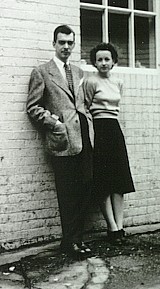 Known as much for his mysterious disappearance as his artistic endeavors, Weldon Kees was born in Nebraska in 1941. He was a talented painter, poet and jazz musician who influenced many later American writers and is considered one of the major literary influences of the 20th Century.
Known as much for his mysterious disappearance as his artistic endeavors, Weldon Kees was born in Nebraska in 1941. He was a talented painter, poet and jazz musician who influenced many later American writers and is considered one of the major literary influences of the 20th Century.
From humble beginnings – his father was a hardware manufacturer and his mother a teacher – his first collection The Last Man is widely seen as one of the most important contributions to American poetry.
Even from a young age, Kees was producing his own magazines and making up shows to impress his friends and family. He grew up in an age when jazz was a formative part of life, with a background in the Great Depression that influenced his later work in maturity. Rather than head into the family business, he attended Doane Arts College in Nebraska and promptly decided he was going to become a novelist. When he graduated he went to University by which time he had written and published a number of works in small presses.
Although it was a good start, when he left university things became more difficult and the three novels Kees wrote failed to find a publisher. Undeterred he turned to poetry and moved to Denver where he studied library science. In 1937 he married Anne Swan and became director for a bibliographical research center in the Rocky Mountains.

By 1941 he had returned to novels and managed to get a contract to write a comedy called Fall Quarter which was about an academic fighting against his own banal world. That same year Pearl Harbor was attacked and the US found itself at war which meant that Kees’ book was ultimately rejected for more patriotic works.
With his pacifist tendencies, Kees moved to New York where the Selective Service conditions meant that he would be unlikely to receive his call-up papers. There he also rubbed shoulders with a number of other writers including William Carlos Williams which helped to develop his literary skills.
The publication of his poetry collection The Last Man earned him a solid reputation and was followed a few years later by his second, The Fall of Magicians. He also published a number of poems in popular literary magazines of the time and also began to develop his own painting, summering in the art community of Princetown with his wife, Anne.
For a while he became involved in abstract expressionism and began to distance himself from the cultural lifestyle of New York. In 1950, Kees and his wife moved to San Francisco and he changed direction once again by taking a job at a psychiatric clinic where he studied nonverbal communication. He continued to write poems and also took up the camera and experimented with jazz.

In 1954, Kees and his wife separated, probably due to her drinking problem. At about the same time that his final collection, Poems, appeared which received moderate reviews. He produced a burlesque style revue called Poets Follies that earned him a certain amount of notoriety but was increasingly restless about his own poetry. Shortly before his disappearance, several friends noticed that Kees was agitated and talked of moving to Mexico.
In July 1955, his car was discovered beside the Golden Gate Bridge in San Francisco. The mystery of his disappearance has never been solved but he was assumed to have taken his own life, at the age of 41.

